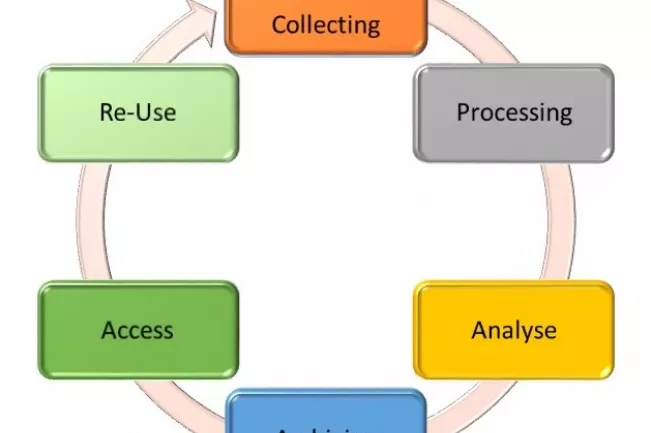University and District Library
Research Data Management

What is Research Data Management used for?
Research Data Management describes the structured handling of (digital) research data. This is intended to ensure that the research results obtained can also be reused. This includes the various steps of the data life cycle as well as major tasks such as organisational, legal and financial aspects. This makes it easier to work according to good scientific practice and conforms to the requirements of the third-party donors, who are increasingly demanding transparency with regard to the data generated by research. In addition, working with own and external data is made easier and precious time is saved.

Research Data Life Cycle
Various models exist to describe the life cycle of research data. The representation shown here is taken from the very informative page Forschungsdaten.info and describes the different stages from the generation to the reuse of digital data.
Planning and Collecting
This step includes the planning of the research project and data collection. If required by the third-party donor, a data management plan should also be drawn up at this stage.
Processing
The received research data will be processed, if necessary digitized and anonymized. A comprehensible system for assigning file names and entering additional information (metadata) facilitates the subsequent retrieval of the data. In addition, the data must be backed up.
Analyse
After evaluating and interpreting the results, the data can be published. This is usually done in the form of a publication. The research data used in the publication must be kept for 10 years in the spirit of good scientific practice (DFG Code of Conduct for good scientific practice).
Archiving
For long-term archiving, suitable file formats must be used, an archive selected and the associated metadata stored. Both subject-specific and general data repositories are suitable for archiving, which can also be subject to a charge depending on the provider. A detailed selection of repositories can be found at https://www.re3data.org/ .
Access
Many scientific journals require the publication of research data in a suitable repository in addition to the article. For this reason, access rights must be defined for archived data. Furthermore, the copyrights and reusability (Creative Commons) of the data should be clearly defined.
Re-use
Many datasets allow you to look at them from a different perspective. This can be done by the data producer as well as by other scientists. On the one hand, new results can be obtained (at this point the data life cycle closes), and old findings can be checked and confirmed. This kind of data can also be used in teaching.
An overview of important aspects can be found on the flyer "Research Data Management".
Library Research Services: bibliothek.forschungsservice@h-brs.de
Contact

Forschungsservices der Bibliothek
Research Services of the Library
Location
Sankt Augustin
Room
A 202.7, A 202.8
Address
Grantham-Allee 20
53757, Sankt Augustin
Telephone
+49 2241 865 -686/-9687/-9876Contact Point
Research Services of the Library
Room
A 202.7, A 202.8
Links
Further links